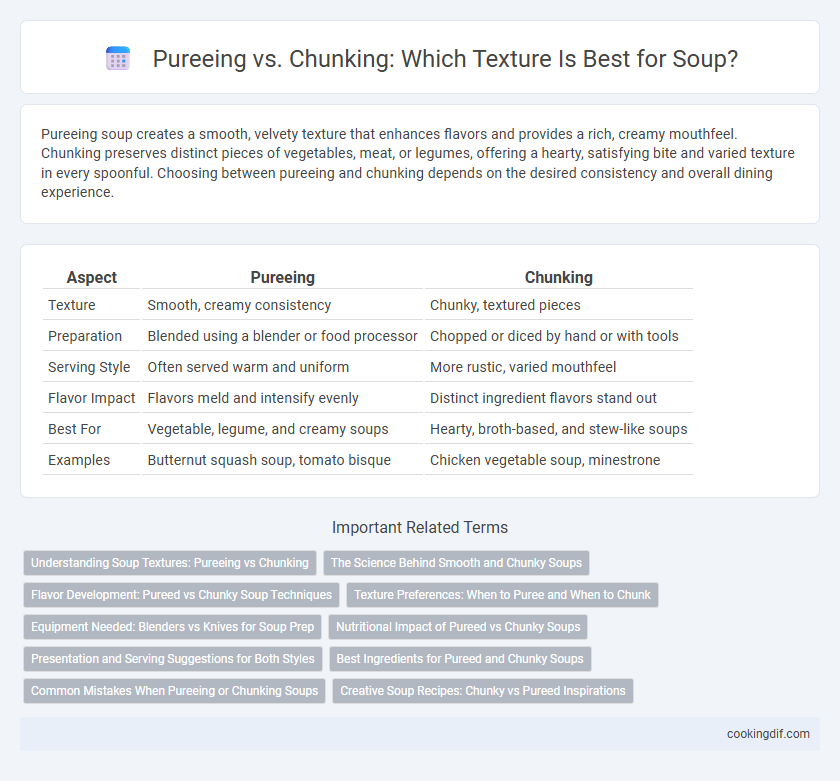Pureeing soup creates a smooth, velvety texture that enhances flavors and provides a rich, creamy mouthfeel. Chunking preserves distinct pieces of vegetables, meat, or legumes, offering a hearty, satisfying bite and varied texture in every spoonful. Choosing between pureeing and chunking depends on the desired consistency and overall dining experience.
Table of Comparison
| Aspect | Pureeing | Chunking |
|---|---|---|
| Texture | Smooth, creamy consistency | Chunky, textured pieces |
| Preparation | Blended using a blender or food processor | Chopped or diced by hand or with tools |
| Serving Style | Often served warm and uniform | More rustic, varied mouthfeel |
| Flavor Impact | Flavors meld and intensify evenly | Distinct ingredient flavors stand out |
| Best For | Vegetable, legume, and creamy soups | Hearty, broth-based, and stew-like soups |
| Examples | Butternut squash soup, tomato bisque | Chicken vegetable soup, minestrone |
Understanding Soup Textures: Pureeing vs Chunking
Pureeing soup creates a smooth, velvety texture that blends all ingredients into a uniform consistency, enhancing flavors by distributing them evenly. Chunking preserves distinct pieces of vegetables, meats, or beans, providing varied mouthfeel and a heartier eating experience. Choosing between pureeing and chunking depends on the desired soup style, with pureed soups like bisques offering creaminess, while chunky soups such as minestrone emphasize texture and ingredient diversity.
The Science Behind Smooth and Chunky Soups
Pureeing soup breaks down ingredients into a homogeneous mixture by rupturing cell walls, releasing starches and fibers that create a creamy texture and enhance flavor integration. Chunky soups retain discernible pieces, preserving the structural integrity of vegetables and proteins, which provides varied mouthfeel and contrast in taste. Enzymatic activity and heat influence the degree of softening, with pureeing often requiring prolonged cooking or mechanical blending to achieve smoothness without compromising nutritional content.
Flavor Development: Pureed vs Chunky Soup Techniques
Pureeing soup creates a smooth texture that allows flavors to meld uniformly, enhancing the overall taste intensity through even blending of ingredients. Chunky soup techniques preserve individual pieces of vegetables or proteins, offering varied mouthfeel and bursts of distinct flavors with each bite. Flavor development differs as pureeing emphasizes harmony and depth, while chunking highlights texture contrast and ingredient prominence.
Texture Preferences: When to Puree and When to Chunk
Pureeing creates a smooth, consistent texture ideal for creamy soups like butternut squash or tomato bisque, enhancing mouthfeel and making flavors meld seamlessly. Chunking preserves the structure of ingredients, providing a hearty, textured experience favored in minestrone or chicken vegetable soups where bite and variation are essential. Texture preferences depend on the desired sensory impact and soup type, with pureeing suited for silky finishes and chunking offering robust, textural contrast.
Equipment Needed: Blenders vs Knives for Soup Prep
Pureeing soup requires a high-powered blender to achieve a smooth, consistent texture, essential for creamy bisques or blended vegetable soups. Chunking soups rely on sharp knives and sturdy cutting boards to create uniform pieces, preserving distinct textures in hearty stews or chowders. Choosing the right equipment impacts soup presentation and mouthfeel, with blenders offering speed and refinement while knives provide control over ingredient size and texture.
Nutritional Impact of Pureed vs Chunky Soups
Pureed soups provide a smooth texture that enhances nutrient absorption by breaking down fibers, facilitating better digestion and nutrient uptake. Chunky soups retain larger vegetable and protein pieces, offering higher fiber content and a more substantial mouthfeel that supports satiety and digestive health. Both textures deliver essential vitamins and minerals, but pureeing may increase bioavailability while chunking preserves more dietary fiber.
Presentation and Serving Suggestions for Both Styles
Pureeing soup creates a smooth, velvety texture ideal for elegant presentations in fine dining, often garnished with a drizzle of cream or fresh herbs to enhance visual appeal. Chunky soups showcase varied textures and vibrant colors, making them perfect for rustic, hearty servings in bowls or bread bowls for a more casual and comforting experience. Serving pureed soups with precise plating and chunky soups with robust, visible ingredients caters to diverse dining settings and preferences.
Best Ingredients for Pureed and Chunky Soups
Pureed soups benefit from ingredients like potatoes, carrots, and cauliflower that create a smooth, creamy texture when blended. Chunky soups excel with hearty vegetables such as celery, tomatoes, and bell peppers, which retain their shape and provide a satisfying bite. Choosing fresh, high-quality produce enhances the flavor and nutritional value in both pureed and chunky soup preparations.
Common Mistakes When Pureeing or Chunking Soups
Common mistakes when pureeing soups include over-blending, which can result in a gluey or overly thick texture, and under-blending, leading to uneven consistency. When chunking soups, cutting ingredients unevenly or adding chunks too large can cause inconsistent cooking and disrupt the desired mouthfeel. Properly balancing the size of chunks and blending time ensures a harmonious texture that enhances the overall soup experience.
Creative Soup Recipes: Chunky vs Pureed Inspirations
Creative soup recipes explore the contrast between pureeing and chunking to achieve distinct textures; pureed soups offer a smooth, velvety consistency ideal for creamy tomato bisques or butternut squash blends. Chunky soups maintain recognizable pieces of vegetables, meats, and legumes, providing a heartier, rustic experience found in minestrone or chicken vegetable variations. Texture plays a crucial role in flavor perception, with pureed forms highlighting subtle ingredient flavors while chunky textures deliver robust bites and varied mouthfeel.
Pureeing vs Chunking for texture Infographic

 cookingdif.com
cookingdif.com